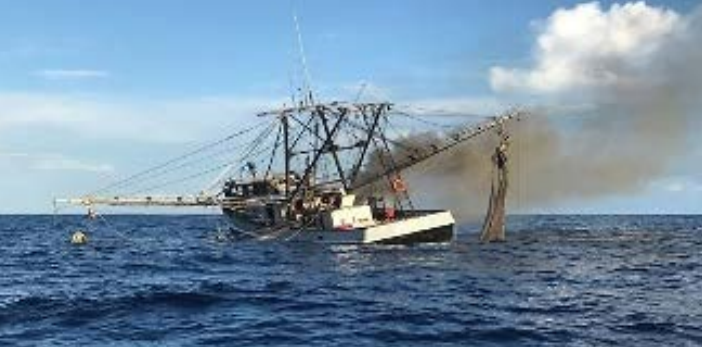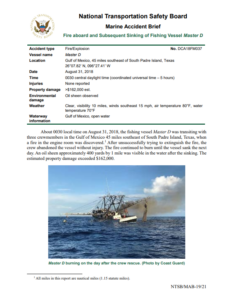The National Transportation Safety Board issued an investigation report on the fire and subsequent sinking of the fishing vessel ‘Master D’ in the Gulf of Mexico in August 2018. The report identified leaking lube oil from the diesel generator as key cause of the fire.
The incident
About 0030 local time on 31 August 2018, the fishing vessel Master D was transiting with three crew members onboard in the Gulf of Mexico.
As the two deckhands were attempting to pull in the net, the electrically powered winch used to position the sample net lost power and the lights on the stern began to dim and flicker before they too went out.
When the captain and the header investigated the problem, they found that the electrical breakers to the winch and lights in the engine room had tripped.
Upon resetting the breakers, the crew was able to retrieve the sample net using the winch. However, the lights in the stern did not turn back on until an hour later. Due to the electrical problems, the captain decided not to redeploy the sample net.
About 0030, while on watch, the captain noticed that electricity in the wheelhouse was lost. Assuming the breaker to the wheelhouse had tripped, he proceeded to the engine room to reset the breaker and restore power.
On the way there, he encountered a burning odor. Shortly thereafter, the fire alarm for the engine room and then the generator failure alarm were heard.
When the captain and the deckhand opened the engine room hatch, they discovered the engine room was filled with smoke and flames.
Because the generator stopped working shortly before the fire was discovered, the crew members could not use the electric water pump to extinguish the fire.
In addition, they could access only five of the seven portable dry-powder fire extinguishers onboard; two were stored in the engine room.
After unsuccessfully trying to extinguish the fire, the crew abandoned the vessel without injury.
However, the expanding fire in the living quarters of the vessel prevented them from retrieving the lifejackets or entering the wheelhouse to broadcast a Mayday call.
The crewmembers then moved the liferaft from the top of the wheelhouse to the deck.
Once in the liferaft, they started to set off flares. After seeing a spotlight of a vessel on the horizon, one of the crew lit off another parachute flare.
The Coast Guard cutter Coho, which had been dispatched to the area in response to the EPIRB alert received by the District 8 Command Center, turned toward them and sped to the scene. At 0330, they were rescued.
The fire continued to burn until the vessel sank the next day. An oil sheen approximately 400 yards by 1 mile was visible in the water after the sinking. The estimated property damage exceeded $162,000.
Probable cause
NTSB determines that the probable cause of the fire aboard the fishing vessel Master D was leaking lube oil from the diesel generator that contacted a hot engine surface and ignited.
Contributing to the eventual sinking was the failure of fire-damaged nonmetallic hoses connected to through-hull fittings below the waterline.
Analysis
Considering that prior to the loss of power, the captain, who was awake at the time, did not hear anything unusual from the engine room, the propulsion engine or the generator’s engine most likely did not experience a mechanical failure or a crankcase explosion, NTSB noted.
The loss of electrical power to the wheelhouse and a burning odor was the first indication that something was wrong.
Investigators determined that the previous electrical system breaker trips (winch and lighting) were not related to the initial fire because the intensity of the fire and smoke was too large when it was discovered.
Additionally, the main engine continued to operate for an hour after the fire was discovered, indicating that both its fuel supply remained adequate and its lube oil system was operating properly.
Based on the location of the flames seen by the captain, along with the intensity of the fire and smoke when it was discovered shortly after the power went out on the bridge, the fire most likely started at the generator.
As noted by the captain, the generator had a lube oil leak, which was not properly repaired prior to the accident voyage.
Although the source of the ignition could not be determined, there would have been several hot surfaces around both the operating main engine and the generator to ignite a fuel or lube oil leak from either engine.
The final loss of power was most likely a result of fire damage to the generator and/or the electrical distribution system near it.
While initial efforts to extinguish the fire by the crew were partially successful, the fire continued to return and expand after each fire extinguisher was emptied and before a new one could be applied.
Thus, the fire had a steady source of material or fuel to support combustion. Depriving the fire of fuel, especially during the early stages of the incident, could have prevented further ignition of flammable materials and increased the likelihood of saving the vessel.
However, because the vessel was not fitted with fuel shutoff valves that were remotely operable, the crew had no way of securing the fuel supply to the diesel engines from outside of the engine compartment once the fire expanded.
The fire’s expansion to the wooden frames, furniture, and dry supplies located inside the forepeak, which included 120 gallons of lube oil, provided additional fuel to sustain the fire. Even as the vessel sank, the fire continued to burn.
The cause of the vessel sinking, which occurred about 30 hours after the fire began, was assessed by investigators.
Because there were no further firefighting efforts by the Coast Guard cutter or by other vessels utilizing water from firehoses, the source of the flooding of the Master D was not external.
The destruction of the nonmetallic hoses connecting intake piping to the vessel’s through-hull fittings, due to the long-term exposure to the heat of the fire, most likely resulted in the sinking of the vessel. As nonmetallic hoses failed, water would have entered the hull causing the vessel to slowly sink,
…the investigation concluded.
Explore more herebelow:































































